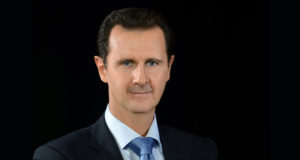By Robert Parry
In blaming Syrian President
Bashar al-Assad for the April 4 chemical incident in Khan Sheikhoun, The New
York Times and other Western news outlets have made a big deal out of
discrepancies in the timing and other details provided by the Syrian and
Russian governments.

A photo of the crater
containing the alleged canister that supposedly disbursed sarin in Khan
Sheikdoun, Syria, on April 4, 2017.
The Times and the others also
have chided anyone who notes that Assad had no logical reason to undertake a
sarin attack since his forces were making solid gains and he had just learned
that the Trump administration was dropping the longstanding U.S. goal of
“regime change” in Syria.
To those of us outside the
mainstream media bubble, there seemed to be little or no military advantage to
be gained. Instead, Assad would be risking more international intervention,
which has ripped his country apart for the past six years. But the Times and
other major outlets dismissed our logic by arguing that Assad was simply
announcing his impunity in some particularly brutal Arab-sort-of-way.
However, neither the value that
the Times and others placed on the Russian-Syrian timing discrepancies nor the
strange explanation of Assad’s motive made any sense. After all, if Assad were
making some bizarre public declaration of his impunity, why would he then deny
that his forces were responsible for the chemical attack? Wouldn’t he simply
say, “yes, I did it and I don’t care what anyone thinks”? Isn’t that what
impunity means: that you do whatever you want knowing that no one can hold you
accountable? Instead, Assad has consistently denied ordering the attack.
The gotcha observation about the
time element of the bombings fails the logic test, too. Why would Syria and
Russia say Syrian warplanes carried out a conventional attack on Khan Sheikhoun
around noon if the actual attack occurred around 6 a.m., as it apparently did?
There was nothing to be gained for them by having the timing off by six hours,
since the point that Syria and Russia were making was that there were indeed
airstrikes but that they were conventional bombs that may have unintentionally
struck an Al Qaeda depot holding chemical weapons and thus released them. The
timing element was immaterial to that point.
What this apparent timing error
suggests is confusion, not “spin,” as the Times insists in a tendentious April
27 video by Malachy Browne, Natalie Reneau and Mark Scheffler, entitled “How
Syria and Russia Spun a Chemical Strike.”
The Syrians and Russians appeared
perplexed by what had happened. Their officials understood that a conventional
airstrike had been carried out and stated what they believed the time was. The
time discrepancy either meant the Syrian air-wing commander had dispatched
warplanes earlier than expected or that some other entity carried out the 6
a.m. strike. But the Syrians and the Russians would seem to have no reason to
lie about this detail.
The Times also makes a big deal
out of Assad denying that the attack took place — and the video then shows some
bombs exploding. But that is just the Times deceiving people. Assad is not
denying that a bombing raid took place; he’s denying his military’s deployment
of chemical weapons.
Intervention by Air
Another false assumption
pervading the Western accounts on this and other chemical incidents in Syria is
that only the Syrian government and its Russian allies have control of the
skies. That is clearly not true. Various military forces, including those of
the U.S. and its allies, as well as Israel and – to some degree – the rebels
have air capabilities in Syria.

Syrian President
Bashar al-Assad.
According to Syrian accounts, the
rebels have captured some government helicopters and apparently used one in
what United Nations investigators were told by multiple
eyewitnesses was a staged chemical-weapons attack in 2014 with the goal of sticking the blame on the
Syrian regime.
Further, the U.S. and its allies
have been conducting airstrikes across much of Syria in campaigns against
Islamic State and Al Qaeda-linked terror groups, which have been supported by
Saudi Arabia, Turkey, Qatar and other Sunni-led sheikdoms. Turkey has been
active, too, with strikes against Kurdish forces. And Israel has hit repeatedly
at Syrian targets to promote what it regards as its interests, including
destruction of Iranian weapons believed headed to the Lebanese militant group,
Hezbollah.
Some – if not all – of these
entities had a far stronger motive to create a chemical-weapons incident in
Syria on April 4 than the Syrian government did. At the end of March, the Trump
administration announced that it was no longer a U.S. priority to overthrow the
Assad government, an announcement that upset several of the countries involved
in the Syrian conflict, including Turkey, Saudi Arabia, the Gulf States and
Israel.
All of them – having committed
resources and prestige to achieve “regime change” in Syria – had motive to
overturn President Trump’s pronouncement. (Israel has had “regime change” in
Syria at the top of its to-do
list since at least the
mid-1990s.) How better to keep that hope alive than to stage another
chemical-weapons attack and blame it on Assad? (Another sarin attack in August
2013 also now appears to have been a staged incident by
Al Qaeda that killed hundreds while
almost tricking President Obama into ordering a massive U.S. military strike on
government forces.)
Shortly after the incident at Khan Sheikhoun, I was told by an
intelligence source that U.S. satellite imagery had picked up what looked like
a drone in the vicinity at around the time that the poison gas was released.
Despite some technical difficulties in tracking its route, the source said the
analysts believed that it may have come from a Saudi-Israeli special operations
base in Jordan, used to assist the rebels.
There are also other combinations
of factors that should have been carefully evaluated before President Trump
jumped to his Assad-did-it conclusion and fired off 59 Tomahawk missiles at a
Syrian airbase on April 6, but they weren’t given serious thought in the rush
to blame Assad.
For instance, Al Qaeda’s clever
propagandists could have again staged a chemical attack on the ground by
creating a crater in the road and inserting what was purported to be a
chemical-weapons canister. The Times and others have noted that the crater was
not visible in earlier satellite images but that observation doesn’t mean the
crater had to be created by an aerial bomb; a ground explosion or simple
digging could have done the trick – with the crushed canister inserted later.
Dubious Narrative
The canister-in-the-crater story struck MIT’s
technology and national security expert Theodore Postol as
particularly odd because on-scene photos showed people climbing into the
supposedly sarin-saturated crater wearing minimal protection and not keeling
over dead. Postol also said the canister appeared to have been crushed rather
than exploded.

Photograph of men in
Khan Sheikdoun in Syria, allegedly inside a crater where a sarin-gas bomb
landed.
There is also the possibility
that some third party with access to sarin or other powerful chemical weapons
could have delivered the poison gas by air – possibly from that drone – with
the rebels either coordinating with that delivery before the fact or reacting
to the opportunity after the fact.
The hard truth is that
intelligence services from a number of countries could fit the bill in terms of
producing sarin or some similar substance that could mimic what Syria once had
in its arsenal, although those chemical weapons were destroyed in 2014 as part
of an agreement hammered out by Russia and the United States.
And there are plenty of ruthless
intelligence operatives on all sides who would have found the deaths of 80 or
so people acceptable collateral damage to advance a geopolitical priority. The
timing, so close to the Trump administration’s major announcement that Assad no
longer had to go, would have represented a logical motive for such a ruse.
The other problem in assessing what has or hasn’t happened in Syria
over the past six years is that all sides, but particularly those seeking
“regime change,” have deployed sophisticated propaganda operations to the
combat zone.

A heart-rending
propaganda image designed to justify a major U.S. military operation inside
Syria against the Syrian military.
Anti-regime activists – financed and supplied by the West and the Gulf
States – understand the emotional value of showing dying children. These
propagandists have regular and uncritical access to major Western media
outlets, from the hipsters at VICE to the neocons and liberal-interventionists
at The New York Times.
In other words, what is still
desperately needed in this latest chapter of the Syrian tragedy is some honest
broker who could conduct a serious investigation that isn’t contaminated by all
the previous propaganda-infused narratives. But the chances of finding that
person or group are slim to none.


No comments:
Post a Comment